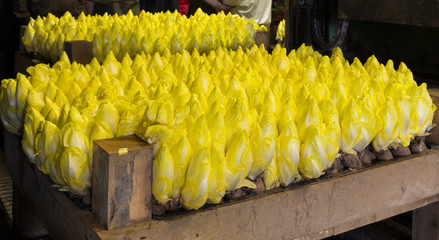Endive and Escarole Blanching, Yield, Harvest and Storage
How to Blanch Endive and Escarole
Blanching aims to produce pale (white-yellowish) headshoots that are sweeter in taste and more tender. Blanching is usually necessary (market demand) when the endive is sold for raw consumption. This process may last 2-3 weeks and usually occurs after the plants’ canopies start touching each other and before harvest. Shoot bleaching is mainly performed with two strategies by professional and amateur endive growers:
- To reduce the labor, many farmers prefer to plant their endives at closer distances [ 20 cm (8 inches) between plants and 40 cm (16 inches) between rows]. This way, the plants have less space to grow, the leaves and shoots stay closer together (less lateral growth), and are shaded from each other (self-shading). Generally, endive can grow relatively well in partly shaded areas. For this reason, some farmers take advantage of this natural shade and plant their endives to facilitate blanching. This strategy is usually combined with selecting self-blanching varieties with more upright narrow shapes and tighter heads like “Traviata.”
- Around 20 days before harvest, growers tie together the outer leaves to protect the heads from sunlight. It is essential to ensure that the leaves are sufficiently dry before tying them together to avoid any fungal diseases and rot.
- Small-scale farmer and amateur gardeners can blanch their endives and escaroles by covering them with a pot or laying a board over the center of the row and the plants.
How much endive yields?
The average yields of endive and escarole may vary from year to year and depend, among others, on the variety, the environmental conditions, the planting time and distances, and the cultivation practices applied. The weight of each plant depends on the variety and cultivation conditions. Broadleaf types (escarole) are heavier and reach up to 600 or more grams per plant. On average, the leaf production of a plant could be around 400-600 grams. A good yield (with 65.000-130.000 plants per hectare) is, on average, 20-30 tons per hectare (8-12 tons per acre). However, there are cases mentioning even higher yields of 45-50 tons per hectare (over 40,000 lb/acre).
When and How to Harvest Endive and Escarole
Most endives reach their full maturity and are ready for harvesting 60-80 days after transplanting and when the blanching process has been completed. However, harvest time depends on their end use and market requirements. Endives that will be sold as baby greens are harvested when they are still young after 40-50 days. By then, they will be 5 cm (2 inches) long. The plants must be harvested on time and not left to over-mature since the leaves become bitter and lose their tenderness. Farmers are advised to complete the harvest of the endive before the weather becomes too hot and dry (for spring crops).
Both endive and escarole, like other leafy vegetables (e.g., lettuce), can also be harvested mechanically with specialized harvesters. Growers harvest endives early in the morning before the sun rises. They manually collect endives using scissors or knives by cutting the rosette from each base close to the ground or carefully pulling the entire plant out of the soil.
Storing Endive and Escarole
Post-harvested and before being released, producers clean the plants from broken, deformed, and discolored outer leaves. After that, the rest of the harvested rosette is washed, sorted, and packaged according to market requirements. For storing endives and escaroles, the ideal condition for more extended storage (up to 2 months) is a 0 ° C temperature and 95-100% relative humidity (to prevent wilting). However, even in such conditions, both species gradually lose their quality after 2-3 weeks in storage. In warmer areas, vacuum cooling or hydrocooling techniques can help maintain the freshness of these leafy vegetables. Endive and escarole are typically packed in cartons (10-20 lb). Depending on the market standards (locally or for exports), no more than 5% of the product can have decay, and a maximum of 10% can have other defaults.
Further Reading
10 Interesting Facts about Endive and Escarole
Endive and Escarole: Health Benefits and Nutritional Value
Endive & Escarole Plant Information and Environmental Requirements
How to Grow Endive (and Escarole) at Home
How to Grow Endive -Escarole for Profit
Endive (and Escarole) Soil Requirements, Preparation and Planting
Endive and Escarole Water Requirements & Irrigation Systems
Endive and Escarole Fertilization Requirements
Endive and Escarole Blanching, Yield, Harvest and Storage
Endive and Escarole Pests and Diseases
References
- https://www.nsalg.org.uk/crop/chicory/
- https://www.uvm.edu/vtvegandberry/factsheets/vegetableberryyields.pdf
- https://www.uaex.uada.edu/publications/PDF/FSA-6068.pdf
- https://extension.umn.edu/vegetables/growing-lettuce-endive-and-radicchio#harvest-445262
- https://cals.arizona.edu/crop/public/docs/azendive.pdf
- https://www.eap.mcgill.ca/CPLV_2.htm
- https://horticulture.oregonstate.edu/oregon-vegetables/endive-and-escarole-0
- https://www.agriculturejournals.cz/publicFiles/00115.pdf
Gajc-Wolska, J., Kowalczyk, K., Radzanowska , J. and Marcinkowska, M. (2012). YIELD AND QUALITY ATTRIBUTES OF ENDIVE (CICHORUM ENDIVIA L.) CULTIVATED IN ROCKWOOL SLABS. Acta Hortic. 927, 367-372










































































